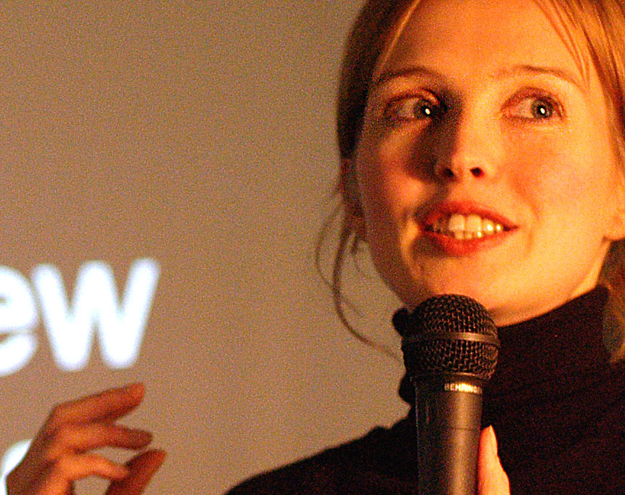As a student of the HKU I followed the Mobtagging workshop organised by Mediamatic. As part of my examination, I made together with 5 other students Ondergrond.org. a platform for Dutch street art by which we use mobtagging. Following some interesting points of the lectures.
Due to this project I had some experience with mobtagging. During the discussions and assignments it was interesting to hear other people are dealing with the same problems we did. A lot of urgent questions passed by. It was refreshing to talk with other people about their opinions and solutions. Very teachable were the lectures. People with their own clear vision on the phenomena mobtagging and related subjects.
Lecture by Jyri Engström: “Why some social network services work and others don't"
After a short introduction about the working of mobtagging Jyri tries to define an answer on the question why he was invited: "Why some social network services work and others don't".
There’s a pattern in the development of social networks. Social networks as Firefly, Sixdegrees and LinkedIn grow to millions of users. However, after a while they collapsed. By these networks users enter into relations with each other. The system is based on the connections between the users. Because that’s the only surplus value, people get focussed on the connections. The system turns into a game. A poor game: to get the most connections.
A good comparison was given by Jyri with social networks in real-life. On high school you get a lot of friends, but when you leave High school the friendship is over. The reason is the disappearing of the common interest, such as school, teachers and going out to the same places.
If you want to make a successful social network there has to be a common interest, a shared object. These objects are the knots of the network, not the people. It has to be clear what the shared object is. For example, if you throw a beachball into a group, everybody knows what to do. If a ball is going in your direction, you slam it to someone else. By pictures on Flickr it’s the same. If you like to take pictures, you upload your pictures at Flickr. You give feedback to others and you except feedback from others. The pictures are the shared object. A tag can be a shared object on its own. For example, the tag css on del.icio.us create a place of common interests. Besides this advantage, the object is always there. Therefore the network is more stable and it can grow over time.
Presentation and demonstration by Andy Smith: “Flock, the Social Browser"
Flock is a social browser, it helps the user to share. Andy showed us why the Flock browser makes your life easier. The Flock browser is a complete desktop for the internet. It combines all the possibilities for the modern internet user. Tags, maps, feeds, blogs, photo’s and favourites. He used the keywords faster, stronger and ‘more fun’ to describes the benefits of this browser. It’s easier to tag your content, find your pictures, write a blog, find out where to go and save things. It is stronger because you can search your history, sort your feeds by topic, synchronise your favourites and upload your photos.
Lecture by Duncan Speakman: “Social tagging and RSS as the engines of the videoblogosphere"
Duncan is a video and sound artist and he zoomed in on social tagging as the main structuring principle of videoblogs.
In general tags are important for video, because the content of video is not searchable yet.
A problem with tagging a video is that you can tag only the whole video. If there’s in one shot a dog, you had to tag the whole movie with dog. If the technology is ready to tag timeframes, this problem is solved. The tags are getting more specific. There’s another new advantage. You can quote a part of a video on your blog or vlog, instead of linking the whole movie.
Like blogs you can have a RSS-feed for your vlog as well. Duncan shows us a clever program FireAnt for organise your videoblogs rss-feeds. With FireAnt you create your one channels to watch your favourite webcasts.
To store your own videos, Duncan shows us two sites. Mefeedia and Youtube are two services that shows the grow of the vlogging scene. He calla attention to del.icio.us, where many videos are bookmarked. If they have the guidencetag ‘watchthis’, you should do that.
Ulla-Maaria Mutanen about: “Metadata, databases, unique identifiers and ThingLinks"
E-Markets are increasingly based on recommendations. If people buy an online product, they’re become recommended with relevant products. Mass media advertising make way for individual recommendations. So a company can recommend all the product they have (long tail), instead of advertise with a small group of popular product (body tail).
The recommendations are made with products with a product code, such as UPC, EPC, SDIN and ISBN. These codes are developed by companies for companies.
But there are a lot of products without a product code. Products from small companies or craft and art. Ulla-Maaria feels that’s not fair. So she is developing a free product code for the invisible tail, called ThingLink. Free unique identifiers with an open database. On the ThingLink website you can create your own eight-digit code and add it to your products. You can find already products by google and wikiproducts.org, but she’s open for new initiatives.
